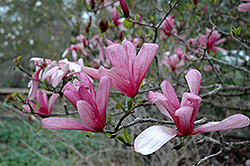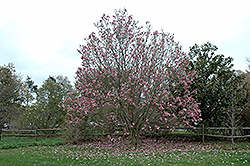Plant Library
Height: 30 feet
Spread: 25 feet
Sunlight:
![]()
![]()
Hardiness Zone: 5a
Description:
A can't-miss accent tree for home landscapes, smothered in large purple-pink flowers in mid-spring, showy for miles around; a tidy tree the rest of the year with a rounded pyramid shape and a strong central leader, good for shade in the front yard
Ornamental Features
Galaxy Magnolia is clothed in stunning fragrant purple cup-shaped flowers with shell pink overtones held atop the branches in mid spring before the leaves. It has dark green deciduous foliage. The large pointy leaves turn coppery-bronze in fall.
Landscape Attributes
Galaxy Magnolia is a deciduous tree with a strong central leader and a distinctive and refined pyramidal form. Its relatively coarse texture can be used to stand it apart from other landscape plants with finer foliage.
This is a relatively low maintenance tree, and should only be pruned after flowering to avoid removing any of the current season's flowers. It has no significant negative characteristics.
Galaxy Magnolia is recommended for the following landscape applications;
- Accent
- Shade
Planting & Growing
Galaxy Magnolia will grow to be about 30 feet tall at maturity, with a spread of 25 feet. It has a low canopy with a typical clearance of 4 feet from the ground, and should not be planted underneath power lines. It grows at a medium rate, and under ideal conditions can be expected to live for 60 years or more.
This tree does best in full sun to partial shade. It requires an evenly moist well-drained soil for optimal growth, but will die in standing water. It is not particular as to soil type, but has a definite preference for acidic soils. It is quite intolerant of urban pollution, therefore inner city or urban streetside plantings are best avoided. Consider applying a thick mulch around the root zone in winter to protect it in exposed locations or colder microclimates. This particular variety is an interspecific hybrid.



